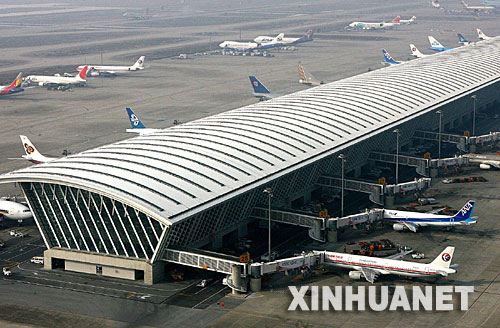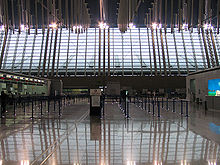
Early development
Prior to the establishment of Pudong International Airport, Hongqiao International Airport was the primary airport of Shanghai. During the 1990s, the expansion of Hongqiao was impossible as the urban area surrounding Hongqiao was developing significantly. As a result, the government had to seek an alternative for Hongqiao International Airport to take all of its international flights. A suitable site was at the coast of the Pudong development zone to the east of Shanghai. The airport was significantly funded by a 40-billion-yen (~450 million USD) Official Development Assistance (ODA) from Japan.[5]
The airport opened on October 1, 1999, replacing Shanghai Hongqiao International Airport as Shanghai's international airport and taking over all of its international flights, including regional flights to Hong Kong and Macau. The first phase of the airport began in October 1997 and took two years to build at a cost of RMB 12 billion (1.67 billion USD). It covers an area of 40 kilometers squared and is around 30 km from downtown Shanghai. The first phase of the airport has one 4E category runway (4000 m x 60 m) along with two parallel taxiways, an 800,000 m2 apron, seventy-six aircraft positions and 50,000 m2 cargo warehouse.
The second and third runways were opened on March 17, 2005 and March 26, 2008 respectively, and a fourth runway is in planning stage. The second terminal was opened on March 26, 2008 and the third terminal is currently at planning stage. The master plan calls for a total of three terminals, two satellite halls, and five parallel runways, ultimately for a capacity of 100 million passengers per year.
Limited international services resumed at Hongqiao Airport in October 2007 with flights to Tokyo International Airport (Haneda) and in November 2007, flights to Gimpo International Airport in Seoul. This is believed to be a major effort to provide convenience to business travelers, a practice already in place between Haneda and Gimpo for years. Hongqiao, Haneda and Gimpo are much closer to their respective metro centers than their newer but remote international gateways Pudong, Narita and Incheon.
Expansion
In 2004, the airport handled nearly 500 flights per day, carrying more than 21 million passengers per year in and out of China's most populated city. Shanghai Pudong International Airport is ranked sixth-busiest in terms of cargo traffic, and 28th in terms of in international passenger traffic. It is also ranked 40th in Passenger traffic, carrying 26,790,826 passengers in and out of the airport. It is the eighth-busiest airport in Asia in passenger traffic.
Shanghai Pudong International Airport had recently experienced massive increases, thus never falling below a 10% growth rate of cargo. From 2002–2003, it had seen near double growth of cargo traffic; 87.3% in that period. From 2002–2006, it has risen from 26th place to 6th place in cargo traffic, with cargo traffic tripling since 2002. In 2006, it had a growth rate of 16.8% while Narita (Tokyo) experienced a -0.5% decrease and Incheon with an 8.7% increase. It may surpass Narita International Airport within a few years and Incheon International Airport to become fourth place in cargo and later Hong Kong International Airport, which is the busiest cargo hub in Asia and second-largest in the world. Complementing that, UPS and DHL will be adding hubs in the next few years and therefore, Pudong will become the first airport to have two international cargo express hubs.
Pudong sees many aircraft movements during rush hour times, resulting in most planes having to park on the apron. To alleviate this, construction of phase two (including a 2nd terminal, a third runway and a cargo terminal) started during December 2005 and was fully complete in time for the Beijing 2008 Summer Olympics; Shanghai Airport Authority played a major role with improvement of facilities.. The architects of Terminal 2 chose to use many world-renowned interior finishes such as Bentley Prince Street and Brinton carpets for this new terminal.
Terminal 2, located behind Terminal 1, opened on March 26, 2008 (same day as the official opening of Terminal 3 at Beijing Capital International Airport), adding an additional capacity of 40 million passengers a year. Once phase two is fully complete, it will give Pudong a capacity of 60 million passengers and 4.2 million tonnes of cargo annually[6]. A transportation center will be added to connect passengers between Terminal 1 and 2 in the future.
Shanghai Airlines moved to Terminal 2 upon its opening on March 26, 2008 with 14 other airlines, including Air India, Northwest Airlines, Qatar Airways, Alitalia, British Airways, Qantas Airways, Virgin Atlantic Airways, Philippine Airlines, Malaysia Airlines, Transaero Airlines, Cebu Pacific, Aerosvit Airlines, Garuda Indonesia and Royal Nepal Airlines. Fellow Star Alliance partners Air Canada, Air China, Air New Zealand, ANA, Asiana Airlines, Lufthansa, Singapore Airlines, Thai Airways and United Airlines have moved on April 29, 2008[7] along with other airlines, involving 33 airlines in all now operating at Terminal 2[6].
The next ambitious expansion, includes the addition of the fourth and fifth runways, a Satellite concourse, larger than the size of both of the current terminals combined, and additional cargo terminals will expand the size of Pudong International Airport. Land reclamation will be included for the fifth runway and some of the cargo terminals. Because of this, a large amount of money will be needed in the future to cope with the demand. This next ambition will be completed by 2015 and will become one of the world-class airports in the world. It will become one of the world's largest airports by land size.
Recently, China Southern Airlines stated that Shanghai Pudong International Airport will be home to its five Airbus A380s, however there is no statement if China Southern Airlines will have a hub in Shanghai Pudong International Airport.
Infrastructure
The airport had 28 boarding bridges along with 127 parking positions and with a tarmac of 1.49 million square meters prior to the opening of Terminal 2. It also has two runways; the 4000-meter runway on category 4E and the 3800-meter runway with a category 4F rating, able to handle the Airbus A380. It is also predicted that the third runway will be on a 4F rating.
Terminal 1 was opened on October 1, 1999 along with a 4000m runway and including a cargo hub. It was built to handle the demand for traffic and to relieve Shanghai Hongqiao International Airport's traffic. Terminal 1 is shaped like Kansai International Airport's terminal, but it is shorter and with 28 gates, 13 of which are double decker gates. The exterior of the terminal is shaped like waves. The capacity of Terminal 1 is 20 million passengers. It currently has 204 check-in counters, thirteen luggage conveying belts and covering an area of 280,000 square meters. Terminal 1 has received some controversy about the lack of shopping stalls, the pricing of the shops, confusing locations of restrooms, the escalators and passenger difficulty of moving through the terminal.
Terminal 2, opened at the 26th of March 2008, along with the 3rd runway, gives a capacity of 60 million passengers and 4.2 million tonnes of cargo annually. Terminal 2 is shaped like the 1st terminal but it has more of a seagull shaping, rather than a wave shape and is slightly larger than Terminal 1. Terminal 2 will be used for Air China, Shanghai Airlines and other Star Alliance members but it is known that some SkyTeam and Oneworld members will relocate their operations to the terminal.


From??http://en.wikipedia.org/wiki/Shanghai_Pudong_International_Airport
Address: ROOM 103, No 10 Ti Yu Guan Rd, Chongwen District, Beijing
copyright@2010北京百达旅游有限公司



